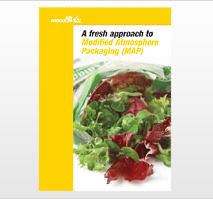Fresh Whole and Prepared Fruit and Vegetable Products

Food items: Atlanta sprouts, Apples, Apricots, Artichoke, Asparagus, Aubergine, Avocado, Bananas, Bean sprouts, Beetroot, Blackberries, Broad beans, Broccoli, Brussels sprouts, Cabbages, Cauliflower, Carrots, Celery, Cherries, Chicory, Courgettes, Cranberries, Cucumber, Cumquats, Fennel, Garlic, Gooseberries, Grapefruit, Grapes, Green berries, Guava, Kale, Kiwi fruit, Leek, Lemons, Lettuces, Limes, Lychees, Mandarins, Mango, Mangosteen, Marrow, Melon, Mixed fruit salads, Mixed vegetable salads, Mulberries, Nectarines, Onions, Oranges, Papayas, Parsnips, Passion-fruit, Peaches, Peas, Peppers, Pineapple, Plums, Potatoes, Prickly pear, Radish, Rambutans, Raspberries, Rhubarb, Rocket, Shallot, Spinach, Star apples, Strawberries, Sweetcorn, Swede, Tomatoes, Turnip, Water chestnuts, Water cress, Watermelon, Yams, other items
Recommended gas mix
N2 sparging, whereby gaseous N2 is bubbled
through liquid food and beverage products, is
used to reduce dissolved O2 concentrations. Storage temperature Achievable shelf-life Principle spoilage organisms and mechanics Food poisoning hazards include |
Typical MAP machines Typical types of package Examples of typical MAP materials Lidding and/or pillow
pack film: Bulk
|
||||||

The principal spoilage mechanisms affecting whole and prepared fresh fruit and vegetable products are microbial growth, enzymic browning, and moisture loss.
MAP which results in depleted O2 and/or enriched CO2 levels is very effective at inhibiting these spoilage mechanisms, as well as:
• reducing respiration
• delaying ripening
• decreasing ethylene production and sensitivity
• retarding textural softening
• reducing chlorophyll degradation
• alleviating physiological disorders
Unlike other chilled perishable foods that are MA packed, fresh fruit and vegetables continue to respire after harvesting and any subsequent packaging must take this into account. The products of aerobic respiration are CO2 and water vapour (whereas fermentation products such as ethanol, acetaldehyde and organic acids are produced during anaerobic respiration). Respiration is affected by numerous intrinsic properties of fresh produce as well as various extrinsic factors but, generally speaking, the Achievable shelf-life of MA packed produce is inversely proportional to respiration rate. The depletion of O2 and enrichment of CO2 are natural consequences of the process of respiration when fresh fruit or vegetables are stored in an hermetically-sealed package. Such modification of the atmospheric composition results in a decrease in the respiration rate of plant material. If produce is sealed in an impermeable film, inpack O2 levels will fall to very low concentrations where anaerobic respiration will be initiated. Anaerobiosis is usually associated with undesirable odours and flavours and a marked deterioration in product quality.



